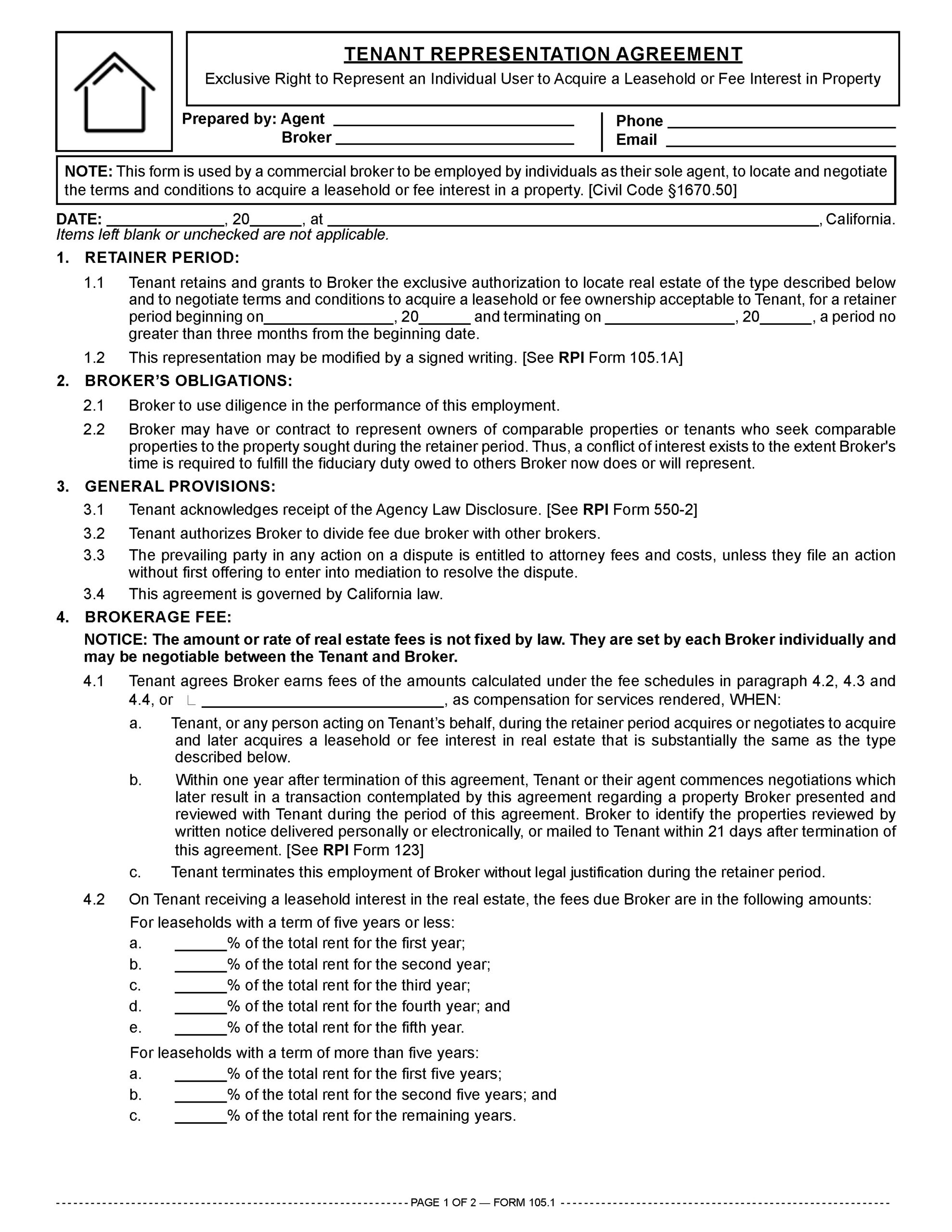This form is used by a commercial broker to be employed by individuals as their sole agent, to locate and negotiate the terms and conditions to acquire a leasehold or fee interest in a property. [Civil Code §1670.50]

Broker representation forms for prospective commercial tenants
As of January 2025, a buyer broker is required to enter into a written employment agreement with their buyer-client when, in expectation of earning a fee, they assist the buyer to locate property available for sale. [Calif. Civil Code §1670.50]
These agreements are commonly referred to as a buyer representation agreement, or BRA for short. [See RPI Form 103.1 and 103.2]
Representation agreements are not solely for buyer brokers who expect a fee when they locate property for a buyer. Seller brokers must continue to enter into seller representation agreements with their seller-clients. Without documentation of the representation, the seller broker cannot enforce collection of a fee earned for marketing the seller’s property for sale. [See RPI Form 102]
Likewise, a broker may assist tenants in expectation of earning a fee, particularly commercial tenants, to locate space for occupancy periods greater than one year and negotiate terms, conditions and pricing suitable to their tenant.
Here, the tenant broker uses a tenant representation agreement to document the period of employment and conditions for earning their fee. [See RPI Form 105.1 and 105.2]
Individual vs. entity clients
The tenant representation agreement employing a broker to acquire a leasehold interest in a property is the leasing equivalent to the buyer representation agreement to acquire a fee interest.
Like the buyer representation agreement, the tenant representation agreement involves a set of two forms, distinguished by whether the tenant-client is an:
- individual [See RPI Form 105.1]; or
- entity. [See RPI Form 105.2]
An entity client includes:
- corporations;
- real estate investment trusts (REITs);
- limited liability companies (LLCs); and
- partnerships.
The retainer period for tenant representation agreements differs depending upon what kind of tenant-client is involved (individual or entity). Thus, two different forms best distinguish the two rules for retainer periods, for both the initial representation period and the renewal or modification of the representation period.
The retainer period for tenants who are individuals may not run longer than three months from the date the agreement is signed. [CC §1670.50(d)(1)]
However, when the tenant is an entity, the retainer period may be for whatever duration the broker and tenant-client negotiate. [CC §1670.50(d)(1)]
For an individual tenant who agrees to renew the representation, the tenant broker uses a Renewal of Tenant Representation Agreement form. [See RPI Form 105.1A]
For an entity tenant agreeing to modify the expiration of the retainer period, the tenant broker uses a Modification of Tenant Representation Agreement form. [See RPI Form 105.2A]
Analyzing the tenant representation agreement
A commercial tenant broker uses the Tenant Representation Agreement published by RPI when employed by individuals or entities as their sole agent. Here, the tenant broker agrees to locate and negotiate the conditions for acquiring a leasehold interest in a property, or as an alternative, acquire a fee interest. [See RPI Form 105.1 and 105.2]
Both versions of the Tenant Representation Agreement contain provisions addressing:
- Retainer period: the tenant broker enters the beginning and end dates of the retainer period. For individuals, this period is limited to no greater than three months from the beginning date. For entities, the retainer period may be negotiated for any length of time and is not limited to the three-month period for individuals employing a broker. [See RPI Form 105.1 and 105.2 §1]
- Broker obligations: the tenant broker agrees to use diligence in the employment as well as disclose conflicts of interest involving their representing other clients with similar needs as the tenant-client. [See RPI Form 105.1 and 105.2 §2]
- General provisions: the Agency Law Disclosure is provided to the tenant as mandated, the tenant authorizes the broker to divide any fee earned with other brokers, and a mediation provision and choice-of-law provision are included. [See RPI Form 105.1 and 105.2 §3]
- Brokerage fee: includes a boilerplate notice about real estate fees being negotiable between the tenant and broker and not fixed by law, as well as the amount and payment of broker fees, including:
- the amount due when the tenant acquires real estate substantially the same as the type sought during the retainer period or within one year, or the tenant terminates the broker’s employment without legal justification during the retainer period [See RPI Form 105.1 and 105.2 §4.1];
- the percent the broker is due to receive each year on a leasehold interest [See RPI Form 105.1 and 105.2 §4.2];
- the amount the broker receives from the tenant on acquisition of fee ownership of the real estate [See RPI Form 105.1 and 105.2 §4.4];
- the tenant is due to pay all broker fees unless the owner agrees to pay them [See RPI Form 105.1 and 105.2 §4.5]; and
- an hourly rate as an alternative to percentage fees. [See RPI Form 105.1 and 105.2 §4.6]
- Type of space sought: the broker enters a general description of the real estate, its location, size, rental amount and term the tenant needs for occupancy. [See RPI Form 105.1 and 105.2]
- Signatures: the broker and tenant date and sign the prepared form.
Form navigation page published 04-2025. Updated 06-2025.
Form updated 2025.
Form-of-the-Week: Tenant Representation Agreements and Renewals — Forms 105.1, 105.2, 105.1A and 105.2A
Form-of-the-Week: Buyer and Tenant Representation Agreements — Forms 103.1, 103.2, 105.1 and 105.2
Article: Buyer Representation Agreements: The end of the “gold standard”
Book: Real Estate Principles, Chapter 76: Commercial lease agreements












